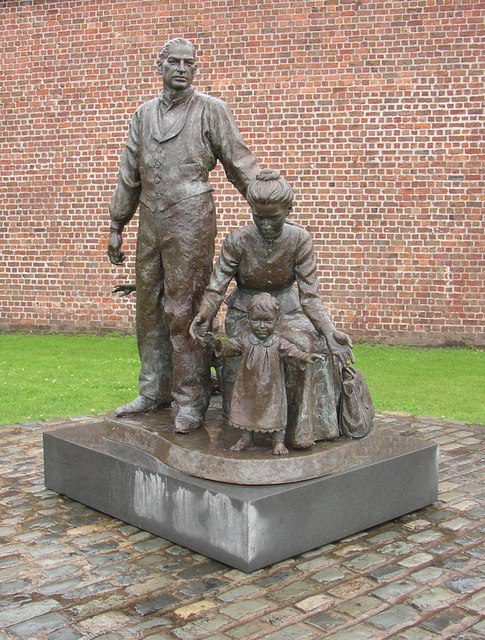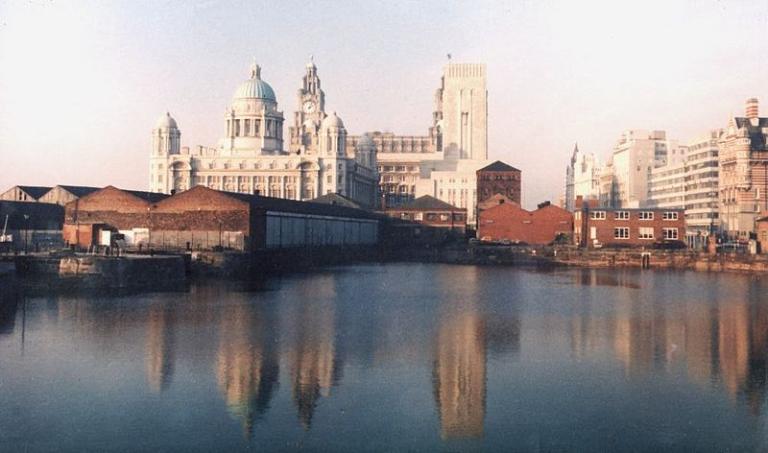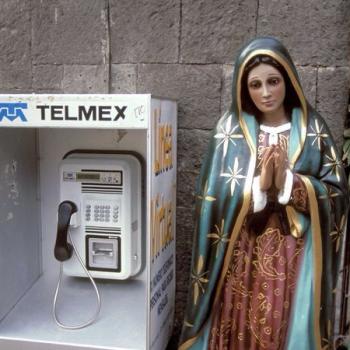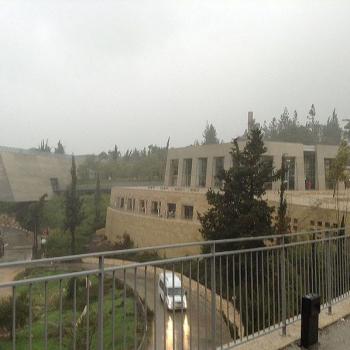
We met up with Kris Frederickson, a member of the Interpreter Foundation board and an organizer and co-host of this Interpreter Church history tour of England and then went to meet our motor coach and our local guide and friend, Peter Fagg, and the rest of our group — save two, who didn’t arrive until dinnertime tonight after flight delays — at the Manchester airport. Thereupon, we drove to the Liverpool Docks, where, walking about the area, we discussed the Beatles, yes, but mostly the Latter-day Saint converts — approximately 85,000 of them — who emigrated to Zion via Liverpool between the start of the Gathering in 1841 or so until it halted in the 1930s.
Liverpool was, for many years, the European headquarters of the Church of Jesus Christ of Latter-day Saints. It was also, by a considerable distance, the principal port of embarkation for members of the Church (and also for nonmembers of the Church, such as my Norwegian Lutheran grandmother) who were departing Northern Europe for North America. Something of the flavor of the Latter-day Saint emigration can be discerned, though, in this eyewitness account that was written from London by an illustrious British novelist:
In June 1863, the passenger ship Amazon set sail from London for America with nearly 900 Latter-day Saint emigrants aboard. However, just before she weighed anchor, many Londoners—including both government officials and clergymen—came to take a look at the “Mormons,” up close and at first hand, as well as at their traveling arrangements. One of these visitors Charles Dickens, the famous author of such works, by that time, as The Pickwick Papers (1837), Oliver Twist (1839), Nicholas Nickleby (1839), The Old Curiosity Shop (1841), Barnaby Rudge (1841), A Christmas Carol (1849), Martin Chuzzlewit (1844), Dombey and Son (1848), David Copperfield (1850), Bleak House (1853), Hard Times (1854), Little Dorrit (1857), A Tale of Two Cities (1859), and Great Expectations (1861). He is generally regarded as one of the greatest novelists of Victorian England and, indeed, in all of English literature.
Dickens spent several hours aboard the Amazon, quietly observing the Saints on the ship and interviewing George Q. Cannon, the English-born member of the Quorum of the Twelve — a native, in fact, of Liverpool — who was serving at the time as the president of the British Mission. (Elder Cannon, who had played a pivotal role in opening the Hawaiian Mission and in translating the Book of Mormon into Hawaiian, would go on to represent Utah as a territorial delegate to Congress and to serve as a counselor in the First Presidency to Brigham Young, John Taylor, Wilford Woodruff, and Lorenzo Snow.)
A month or so after his visit to the Amazon, Dickens published an account of his experience in an essay for the periodical All the Year Round (4 July 1863), titled “The Uncommercial Traveller.” In his essay, he remarked that virtually all of the emigrating Latter-day Saints were tradesmen and craftsmen and their families, people of the working class. He was worried about what these British converts to “Mormonism” might encounter when they actually arrived in Utah. (He was surely familiar with the horror stories going around England at the time – which would continue for the next several generations — about the theocratic “Mormon kingdom” in the remote North American west.) But he was deeply impressed by what he had actually seen. The emigration was thoroughly well-organized, calm, orderly.
“I went on board their ship,” he wrote, “to bear testimony against them if they deserved it, as I fully believed they would; to my great astonishment they did not deserve it; and my predispositions and tendencies must not affect me as an honest witness. I went over the Amazon’s side feeling it impossible to deny that, so far, some remarkable influence had produced a remarkable result, which better known influences have often missed.” Of the Saints themselves, Dickens confessed that, had he not known they were Latter-day Saints, he would have described them as, “in their degree, the pick and flower of England.”

In the meanwhile, the dying if not altogether dead website of the Interpreter Foundation continues to not change. Here are some of the most recent examples of its complete lack of change:
“Anachronisms: Accidental Evidence in Book of Mormon Criticisms,” Chapter 3, “Metals and Metallurgy,” written by Matthew Roper
[Editor’s Note: We are pleased to present chapter 3 from a book entitled Anachronisms: Accidental Evidence in Book of Mormon Criticisms. It is presented in serialized form in this volume of Interpreter: A Journal of Latter-day Saint Faith and Scholarship.]
“Interpreting Interpreter: (Non-)Anachronisms – Metallurgy,” written by Kyler Rasmussen
This post is a summary of the article “Anachronisms: Accidental Evidence in Book of Mormon Criticisms — Chapter 3: Metals and Metallurgy” by Matthew Roper in Volume 65 of Interpreter: A Journal of Latter-day Saint Faith and Scholarship. All of the Interpreting Interpreter articles may be seen at https://interpreterfoundation.org/category/summaries/. An introduction to the Interpreting Interpreter series is available at https://interpreterfoundation.org/interpreting-interpreter-on-abstracting-thought/.
A video introduction to this Interpreter article is now available on all of our social media channels, including on YouTube at https://youtube.com/shorts/SgYKrb52OBE.
The Takeaway: Roper continues his examination of claimed Book of Mormon anachronisms, looking at 16 different items related to metals and metallurgy. He concludes that 50% of these supposed anachronisms have received subsequent confirmation in the archaeological record, with and additional 4 partially confirmed, and 3 items that are yet to trend toward confirmation (iron smelting and steel in the new world, and silver money).
Abstract: This paper examines Joseph Smith’s approach to translation, using the Book of Abraham as a case study to explore the interplay between divine revelation and human participation in scriptural production. While the Book of Abraham incorporates both ancient and modern elements, its unique synthesis resists simple categorization as either an unblemished Abrahamic autograph or a purely nineteenth-century pseudepigraphon. Drawing on historical evidence and textual analysis, this paper aims to illuminate Joseph Smith’s role as both translator and revelator, offering insights into how Latter-day Saints might understand the complex process of producing sacred texts.
[Editor’s Note: An earlier version of this paper was delivered at the annual Joseph Smith Papers Conference in Salt Lake City on 26 October 2018.]
“Interpreting Interpreter: Joseph’s Fingerprints in the Book of Abraham,” written by Kyler Rasmussen
This post is a summary of the article “Joseph Smith Jr. as a Translator: The Book of Abraham as a Case Study” by Stephen O. Smoot in Volume 64 of Interpreter: A Journal of Latter-day Saint Faith and Scholarship. All of the “Interpreting Interpreter” articles may be seen at https://interpreterfoundation.org/category/summaries/. An introduction to the “Interpreting Interpreter” series is available at https://interpreterfoundation.org/interpreting-interpreter-on-abstracting-thought/.
A video introduction to this Interpreter article is now available on all of our social media channels, including on YouTube at https://youtube.com/shorts/BZpKypZon0k.
The Takeaway: Smoot argues that various aspects of the Book of Abraham show evidence of Joseph Smith’s influence as a translator, despite the text itself having a number of authentic ancient elements.
The Temple: Plates, Patterns, & Patriarchs: ““Eastward” in Genesis 2-4: An Exercise in Visual Discovery,” written by Rebecca Holt Stay
Part of our book chapter reprint series, this article originally appeared in The Temple: Plates, Patterns, & Patriarchs, edited by Stephen D. Ricks and Jeffrey M. Bradshaw. For more information, go to https://interpreterfoundation.org/books/the-temple-plates-patterns-patriarchs/. For video and audio recording of this conference talk, go to https://interpreterfoundation.org/conferences/2022-temple-on-mount-zion-conference/videos/stay/.
“Genesis 2–4 is one of many Creation stories in the Old Testament. Studying one account deeply and separately from the others may reveal insights lost when we attempt to harmonize them.”
Posted from Preston, Lancashire, England














